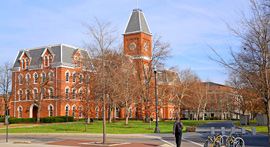Academics
Students live by “the Gentleman’s Rule” at the all-male Wabash College in Crawfordsville, Indiana. Backed by an “exceptional” academic reputation and preparation for graduate professional schools (“Wabash’s medical school acceptance rates are above 80 percent”), Wabash is “truly an A school for B students.” As one student puts it, Wabash “opened the world up to me and changed the arc of my life.” The school has a “great alumni base” and “does a great job of making opportunity for students in the Rust Belt.” Professors come highly recommended, described as both “outstanding” and “down to earth” and not only “always have their doors open for questions,” but sometimes also open their homes as well for “dinner and discussion about an assignment or topic that is bothering you.” The “classes are tough but rewarding” and require “lots of reading…and critical thinking.” There is plenty of “opportunity for students to take leadership positions on campus,” with students having “a lot of control over their budget,” as one example. Students also praise Wabash’s office of “career services” and “immersion learning.” And not for nothing, students feel respected and heard: “I think that our school does a great job of…engaging with the students and allowing their voices to be heard equally with that of the professor in order to progress the narrative and enhance the learning process, rather than just dismissing student perspectives as background noise.”
Student Body
This “800-odd all male campus in rural western Indiana is more than just a brotherhood.” Students generally hold each other in high esteem: “When I go out into the world, if I find another Wabash man, the connection we have is instantaneous,” one student says. “Our experiences, while different, are rooted in the same traditions and ideals, and thus, we can share a bond, despite the other man being 10, 20, 30, 40, or even 50 years older.” An “openly gay” student observes that the “overall atmosphere…is a welcoming and accepting one; I feared attending a small campus in Indiana, but, entering my last semester, I realize it is incredibly easy to find a loving group of individuals. I truly believe a great majority of Wabash’s students embody the Gentleman’s Rule and act accordingly.” The student body is a “diverse melting pot of all kinds of students.” From “rural Midwestern towns to rough inner city neighborhoods in Philly and Chicago, to affluent suburbs and many foreign countries, the student body at Wabash is home to a breathtakingly wide array of perspectives and beliefs.” This amount of diversity “poses a positive challenge to Wabash men, as it gives us the ability to open our eyes to new ways of thinking and living…and also teaches how to go into a new and changing world.”
Campus Life
“Our school spirit and tradition-oriented culture is second to none!” exclaims one student. Wabash is an “academically rigorous school,” with classes running until around 4:00 p.m. and the remaining weekdays “devoted to studying.” That said, “extracurriculars are easy to come by” and many students “compete in intramural sports.” Students also tend to be “very involved with extracurricular organizations,” which include “jazz band, “dance marathon, “German club,” and “College Mentors for Kids.” The “surrounding area is very rural, so life is centered around the campus.” Greek life is also big, as “over half of the campus is in a fraternity,” and on weekends, “a fraternity is almost always holding a party on Friday and Saturday nights.” There are “campus unity tours (otherwise called TGIF)” where students “go to each fraternity house and living unit and socialize for fifteen minutes or so,” a “great way to get to know people.” The Wabash “brotherhood” also “love to support athletic teams.” The football home section is “almost always sold out.” About “half of the student body plays a sport,” and the vast majority of the student body is “in a schoolsponsored club or organization.” On weekends, students are also down to take a “quick trip to Lafayette or Indianapolis to experience the bigger-city life.”




